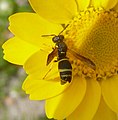پرونده:Odynerus spinipes^ Vespidae. See parasite note - Flickr - gailhampshire.jpg

اندازهٔ این پیشنمایش: ۵۱۹ × ۶۰۰ پیکسل. کیفیتهای دیگر: ۲۰۸ × ۲۴۰ پیکسل | ۴۱۵ × ۴۸۰ پیکسل | ۶۵۴ × ۷۵۶ پیکسل.
پروندهٔ اصلی (۶۵۴ × ۷۵۶ پیکسل، اندازهٔ پرونده: ۱۶۶ کیلوبایت، نوع MIME پرونده: image/jpeg)
تاریخچهٔ پرونده
روی تاریخ/زمانها کلیک کنید تا نسخهٔ مربوط به آن هنگام را ببینید.
| تاریخ/زمان | بندانگشتی | ابعاد | کاربر | توضیح | |
|---|---|---|---|---|---|
| کنونی | ۱۴ اکتبر ۲۰۱۷، ساعت ۱۳:۲۱ |  | ۶۵۴ در ۷۵۶ (۱۶۶ کیلوبایت) | Chiswick Chap | Cropped 31 % horizontally and 22 % vertically using CropTool with precise mode. |
| ۸ ژوئیهٔ ۲۰۱۶، ساعت ۲۱:۴۸ |  | ۹۵۲ در ۹۷۲ (۱۸۳ کیلوبایت) | Josve05a | == {{int:filedesc}} == {{Information |Description=Most Strepsiptera (also known as twisted-wing parasites) live as internal parasites of bees, wasps, grasshoppers, leafhoppers, and other members of the order Hemiptera. Only a few species that parasit... |
کاربرد پرونده
صفحهٔ زیر از این تصویر استفاده میکند:
کاربرد سراسری پرونده
ویکیهای دیگر زیر از این پرونده استفاده میکنند:
- کاربرد در en.wikipedia.org
- کاربرد در gl.wikipedia.org
- کاربرد در ja.wikipedia.org
- کاربرد در la.wikipedia.org
- کاربرد در tr.wikipedia.org